Urban Wildlife Conflicts
%203x1_5.jpg)
Sometimes urban species can come into conflict with us or our pets.
The way we build cities usually reduces the number of wildlife species that can exist in an area. However, some species are quite good at adapting to living in the city. These species can sometimes come into conflict with us or our pets.
Free-Ranging Pets Harm Wildlife
Free-ranging domestic cats harm native wildlife.
Free-ranging domestic cats are estimated to be the single greatest source of human-related mortality of wildlife according to research. Cats roaming neighborhoods kill billions of birds and mammals each year in the U.S. The domestic cat has been introduced across the globe and is listed as one of the 100 worst invasive species in the world. To try to address this, some recommend trap/neuter/release (TNR) programs where free-ranging cats are caught, neutered, then released back into the “wild”. Unfortunately, research shows that such programs do not work and are not humane. Research shows they do not control cat populations and do nothing to stop the impact on wildlife.
Dogs Off-Leash Harm Wildlife
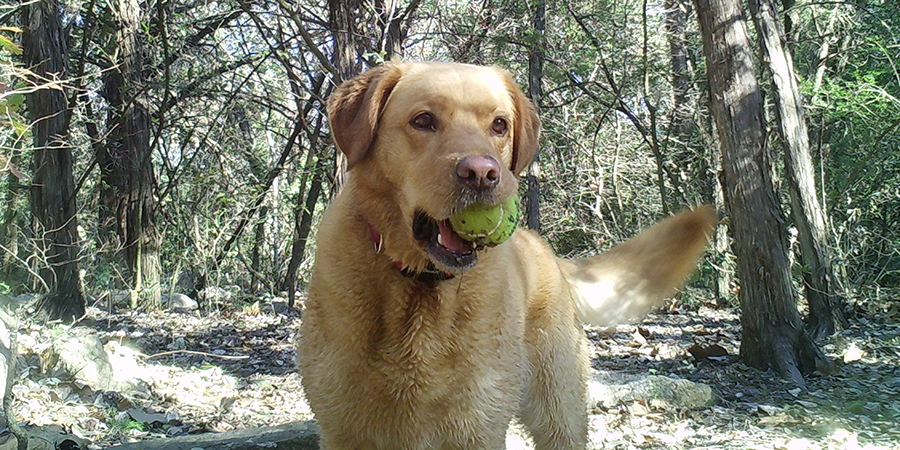
Dogs roaming off-leash in natural areas harm or stress wildlife.
Everyone loves to see their dog frolic and play, but natural areas are not the place for this. Research has shown that domestic dogs roaming off-leash chase and attack wildlife. Even if wildlife isn’t physically harmed, increased stress from such encounters negatively impacts wild animals. Such stress is known to make some species avoid habitat near trails where dogs roam.
Free-Ranging Pets are at Higher Risk
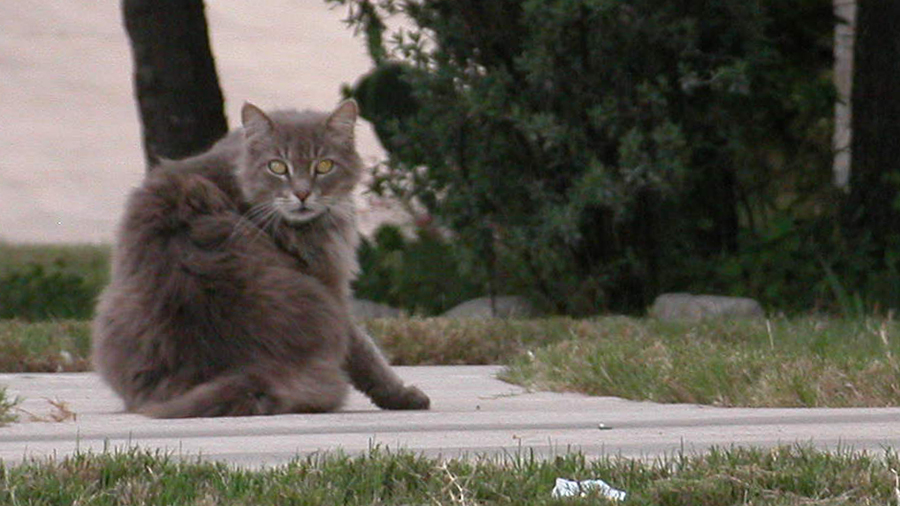
Pets allowed to roam freely outdoors are at risk of injury, disease, and predation.
In addition to free-range pets posing a threat to wildlife, they are also at higher risk of harm. The life of a free-ranging pet is not easy. They may be hurt by collisions with cars, disease, injuries from fights, parasites, unwanted breeding, and predation. It is well-documented that coyotes and owls will prey upon smaller pets. Similarly, a dog roaming off-leash in a natural area that encounters a coyote during breeding season will be considered a threat and is likely to be attacked.
Protect Your Pet
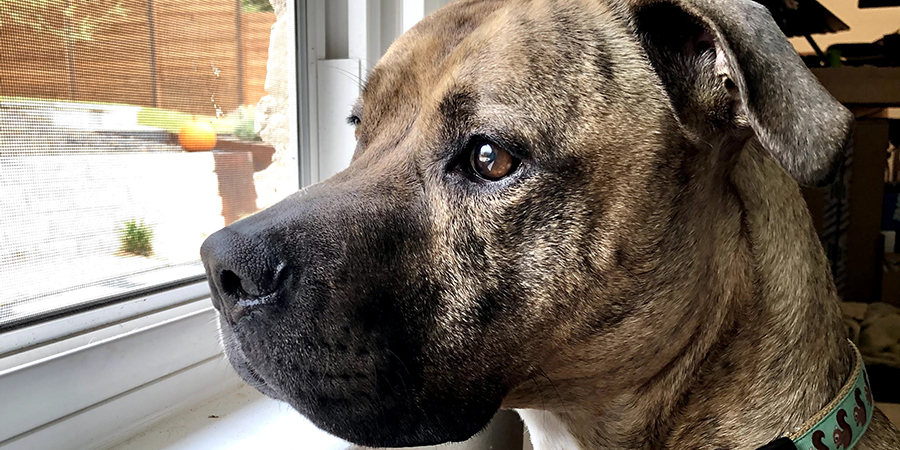
Protecting pets while keeping wildlife safe is best for all.
It is most humane to protect your pet by keeping it confined. It’s best for cats and for wildlife to keep cats indoors or provide them with a protected “catio”. Keeping your dog in your yard or on a leash while out is the best way to protect it and wildlife. If your dog is a small breed, fencing alone is not sufficient protection as some predators can enter fenced yards.
Coyotes

Dr. Stanley Gehrt is the principal investigator of the Cook County Coyote Project, a decades-long study of urban coyotes in the Chicago area. His research shows that most urban coyotes are active at night and prefer to remain in natural areas while avoiding urban land uses. They also mostly feed on rodents or other small mammals and fruit dropped from trees. Contrary to what some think, the diet of most urban coyotes is not pets or trash. However, some become habituated and begin behaving badly.
Watch the video below from Texas Parks and Wildlife Department to learn more about the different levels of coyote behaviors.
If you live in Austin and see a coyote displaying any behavior other than retreating, report the encounter at 3-1-1 (512-974-2000).
To keep coyotes afraid of humans, hazing is often effective. Watch the video below from Texas Parks and Wildlife Department to learn what to do should you encounter a coyote.
To avoid conflicts with coyotes, keep cats and small dogs indoors. Don’t leave pet food out overnight. Secure all trash receptacles. Don’t rely on a 6 ft. privacy fence to protect pets or poultry. Coyotes can easily get over a 6 ft. fence.
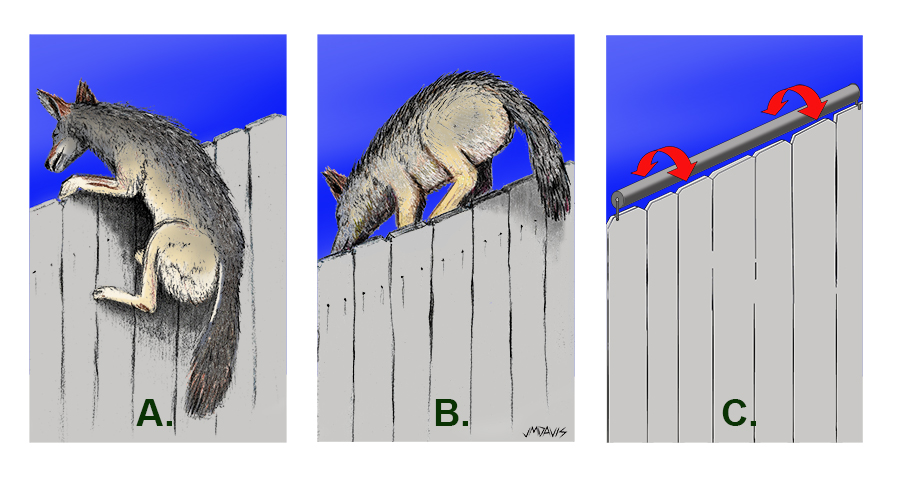
Coyote hooks its paws on top (A). It brings the back legs up to propel itself over (B). A fence roller spins and prevents this maneuver (C).
They hook their front paws on top, then use their hind legs to propel them upward and over. To keep coyotes from scaling/jumping your fence, make sure it’s at least 6 ft. high and has a “fence roller” installed along the top. The combination of a vertical wrought iron fence with a roller on top is the most effective design. It prevents the front paws from getting traction at the top and doesn’t provide a solid surface for them to use their hind legs to climb. You can purchase fence roller systems commercially or make your own. Just search online for “fence rollers.”
Birds of Prey
Birds of prey (hawks, owls, etc.) can come into conflict with us in several ways. A great resource about urban birds of prey is Urban Raptors: Ecology and Conservation of Birds of Prey in Cities.
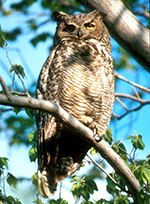
Birds of prey, like this Great Horned Owl, are majestic and powerful predators.
Various birds of prey in the Austin area (Great Horned Owls, Red Tailed Hawks, etc.) are large enough to take small pets or poultry. Others, like Coopers Hawks, are adept at taking birds from bird feeders. These issues are all addressed similarly by separating these predators from prey by fencing or by time of day. If you have poultry, there must be an area for them to roost that is completely enclosed to protect them from predators of all types. Keep cats indoors to protect them as well. If you have a small dog that needs to be let out for bathroom breaks, create an enclosed space for it or keep it near you to discourage bird attacks.
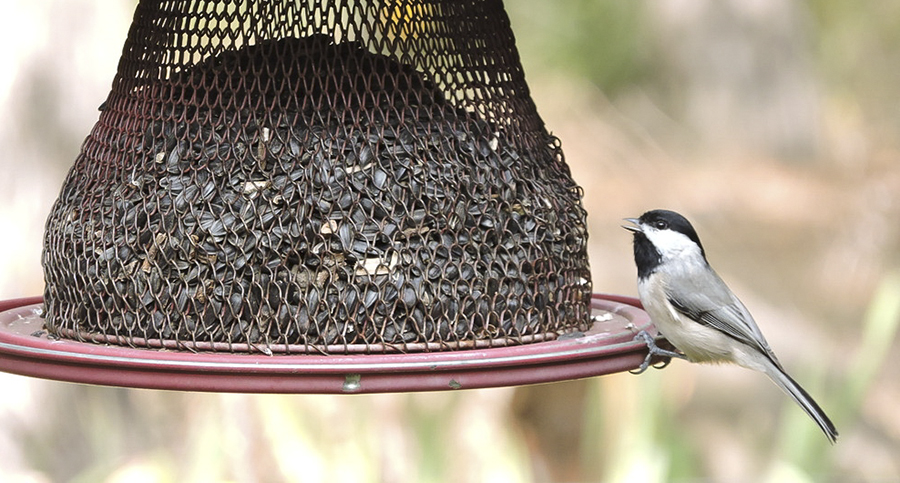
Carolina Chickadee at a feeder.
Hawks Hunting at Feeders
If you notice a bird of prey taking birds at your feeder, it is important to realize that your feeder is simply feeding birds a little higher up the food chain. Raptors rely on speed and surprise to take birds at feeders. If this is not acceptable, anything you can do to slow the hawk's approach and give songbirds time to react will reduce predation. Birds feeding on the ground or on platform feeders are at greatest risk as they generally do not have structure over them to protect them and their routes of escape are slower and more predictable. If you notice hawks hunting your feeders, you can simply take them down for a week or two and the hawks will hunt elsewhere. If you want to leave feeders out, then feeders with domes overhead that are not see-through can reduce the chance of a hawk seeing prey at the feeder. Also, you can buy feeders with wire cages around them, or make your own using 2 inch by 4 inch "welded wire" mesh you can get at the local hardware store. Such wire caging will allow smaller birds to enter and feed safely while protecting against ambush.
Birds of Prey in Warehouses
Birds of prey may inadvertently find themselves inside warehouses. They pursue prey (small mammals, birds, or insects) near the opening of large, retractable doors and the momentum of the pursuit carries them in and they struggle to exit. Often, scattering bird seed in the open doorway helps reverse the process. Birds gather to feed. The bird of prey pursues them, and momentum carries it outdoors again.
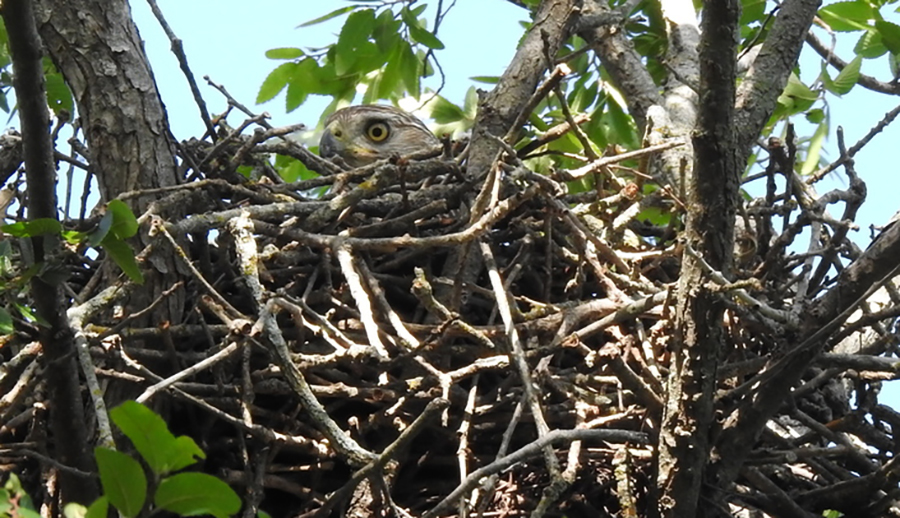
Cooper’s Hawk in a nest.
Birds of Prey Swooping or Dive-Bombing
During nesting, it’s not uncommon for birds to defend the surrounding area (sometimes 100 or more feet from the nest) by swooping near intruders. It is critical to understand that these species are federally protected and can't be hunted or harmed. Also, this behavior is temporary and will stop once young have fledged. If possible, give the nest space and don’t walk close enough to illicit defense behavior. If avoidance is not possible, you may be able to eliminate the diving behavior by installing a tarp, walkway cover, or other visual barrier to keep the birds from seeing people walking by, thus feeling threatened. If avoidance or installing a visual barrier is not possible, simply deploy an umbrella over your head to prevent contact should a bird swoop toward you.
Wildlife in Unacceptable Places
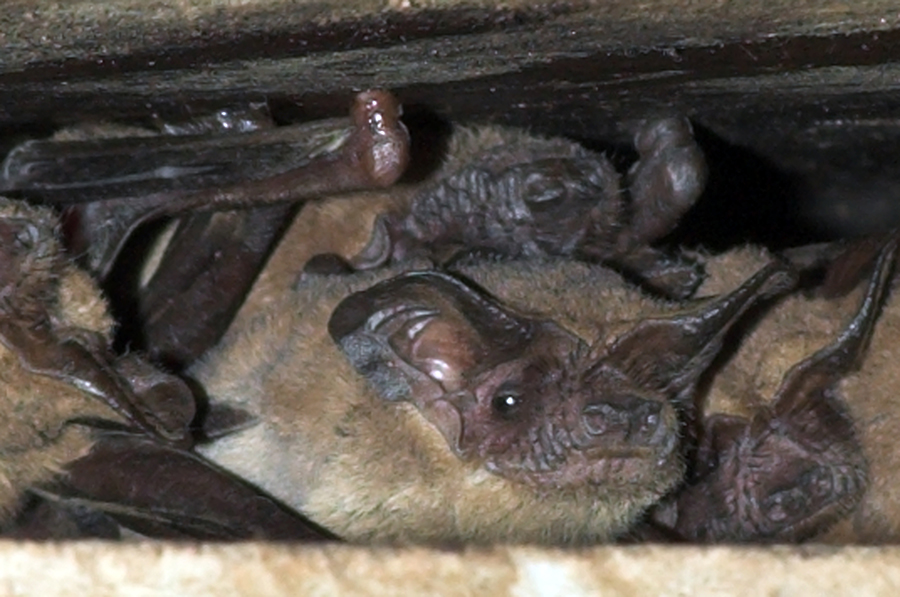
Bats in a crevice. (photo courtesy of Texas Parks and Wildlife Department)
While it is wonderful to enjoy wildlife in our yards, some species may take up residence in unacceptable areas. Squirrels, raccoons, bats, etc., seem to have a knack for getting into attics, crawl spaces, garages, sheds, etc. It is not healthy to allow animals to den or roost in structures occupied by people as disease transmission becomes a concern. Should you discover an animal living in an unacceptable area, contact a commercial wildlife removal service. There are many humane ways to remove animals, but to avoid being bitten or exposed to disease, contact someone who does this work for a living. The best solution often involves ensuring there are no young in the denning area, then installing a “one-way” door to allow the animal to leave and not return. Once it is certain the animal has gone, seal the entrance. This leaves the animal in its territory while eliminating the conflict of denning in an area occupied by humans.
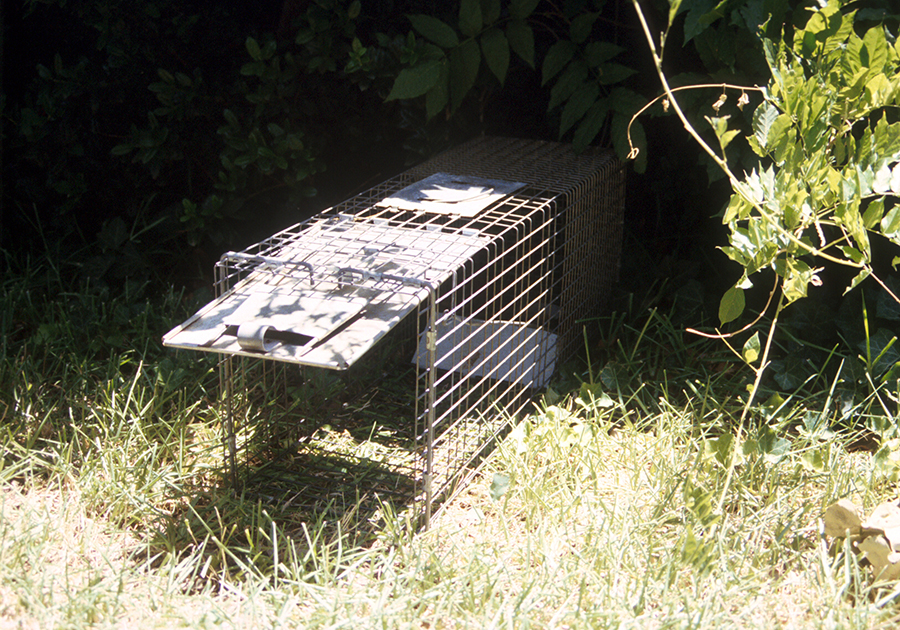
Trapping and relocating wildlife is not recommended.
Contrary to popular belief, trapping and relocating is not humane and is not recommended. First, the animal will often be replaced by another one from nearby. Second, there are animals at the release site that have established territories and will fight the newcomer. Third, if not released far enough away, the relocated animal immediately begins the journey to its home territory and often gets killed crossing roads. Should the animal make it back to its territory, and the den site hasn’t been sealed, the problem will recur. Therefore, it’s most humane to exclude the animal from the unacceptable area while allowing it to maintain its territory.
Exotic Rodents
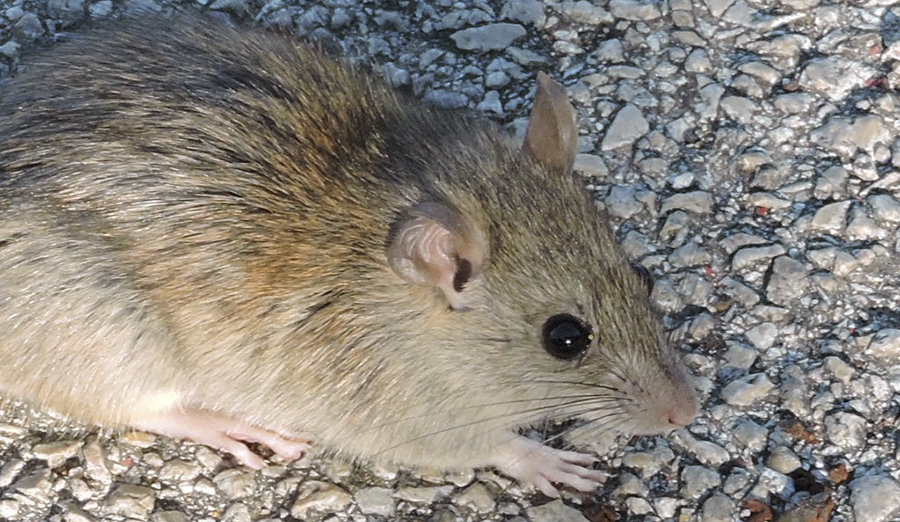
An exotic black rat (Rattus rattus).
Exotic rodents such as the black rat (Rattus rattus), brown rat (Rattus norvegicus), and the house mouse (Mus musculus) are covered on this page due to their impact on native wildlife both directly and indirectly. These species impact native wildlife by directly feeding on bird eggs as well as food items like seeds and berries that native wildlife need for survival. They indirectly impact native wildlife in a type of "guilt by association”. Communities with a rat problem often assume grasslands, wetlands, and woodlands are the source of infestation and, therefore, remove such habitats. This impacts many native species depending on those habitats.
Let's not destroy habitat for native wildlife out of fear of exotic rodents.
Exotic rodents are commensal species meaning that they benefit from living in association with humans. Research done in the United States and elsewhere demonstrates that exotic rodents do not prefer to be in natural habitats. They prefer to live in, around, or under our structures. Though it is practically impossible to permanently eradicate these species, there are some sanitation practices that can help limit populations by reducing food sources:
- Clean up bird seed spillage and don’t leave feeders and pet food out overnight.
- Keep grills clean and trash can lids secured.
- Place new food scraps deep within the compost pile or use a container that keeps rats from accessing the material.
Don’t Remove Native Food Sources

Native plants like American beautyberry (left), inland seaoats (middle), and Mexican plum (right) provide food for many species of native wildlife.
Although removing artificial food sources like pet food and table scraps is recommended to keep exotic rodent populations down, removing seeds and fruits produced by native plants is not. Hundreds of native wildlife species depend on native plants for food. Eliminating these native food sources in hopes of controlling exotic rodents is misguided and does more ecological damage than good.
Controlling Exotic Rodents
%20small.jpg)
Traditional traps may or may not be enough.
Exotic rodents are quite wary, and rats are smarter than most people realize. Therefore, traditional snap traps may eliminate a few individuals, but others will learn to avoid them. If you have one or two rats that have moved into your shed or garage, try the large snap traps you can get at any hardware store. Many people have success applying peanut butter to the trigger plate, but many rats have learned how to eat it without tripping the trap. Also, black rats like fruits and nuts. It’s best to “pre-bait” a few nights without the trap set to allow them to get comfortable. Then add more bait and set it. You may increase success by wiring or tying pieces of fruit or raisins to the trigger plate to prevent rats from carefully lifting bait from the plate without triggering it.
%20small.jpg)
Use string or wire to attach pieces of fruit to the trigger plate if rats are taking your bait.

